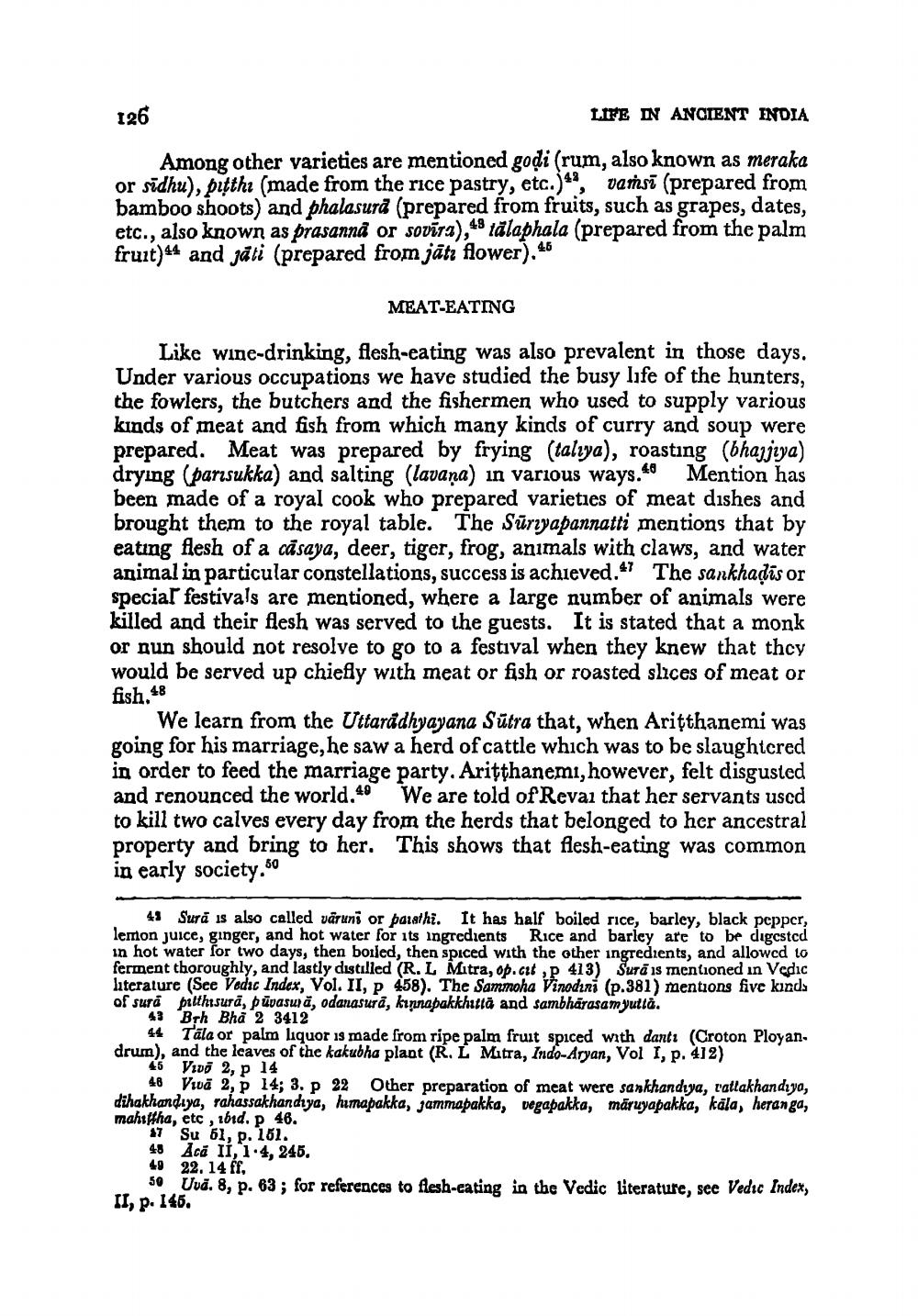________________
126
LIFE IN ANCIENT INDIA
Among other varieties are mentioned godi (rum, also known as meraka or sidhu), pitthi (made from the rice pastry, etc.), vamsi (prepared from bamboo shoots and phalasurd (prepared from fruits, such as grapes, dates, etc., also known as prasannà or sovīta), 48 talaphala (prepared from the palm fruit)44 and jāti (prepared from jātz flower). 46
MEAT-EATING
Like wine-drinking, flesh-eating was also prevalent in those days. Under various occupations we have studied the busy life of the hunters, the fowlers, the butchers and the fishermen who used to supply various kinds of meat and fish from which many kinds of curry and soup were prepared. Meat was prepared by frying (taliya), roasting (bhajjiya) drying parisukka) and salting (lavana) in various ways.co Mention has been made of a royal cook who prepared varieties of meat dishes and brought them to the royal table. The Sürzyapannatti mentions that by eating flesh of a căsaya, deer, tiger, frog, animals with claws, and water animal in particular constellations, success is achieved.47 The sankhadis or special festivals are mentioned, where a large number of animals were killed and their flesh was served to the guests. It is stated that a monk or nun should not resolve to go to a festival when they knew that they would be served up chiefly with meat or fish or roasted slices of meat or fish.48
We learn from the Uttaradhyayana Sutra that, when Ariţthanemi was going for his marriage, he saw a herd of cattle which was to be slaughtered in order to feed the marriage party. Arițţhanemi, however, felt disgusted and renounced the world. We are told of Revai that her servants used to kill two calves every day from the herds that belonged to her ancestral property and bring to her. This shows that flesh-eating was common in early society.
43 Surā is also called väruni or parathi. It has half boiled rice, barley, black pepper, lemon juice, ginger, and hot water for its ingredients Rice and barley are to be digested in hot water for two days, then boiled, then spiced with the other ingredients, and allowed to ferment thoroughly, and lastly distilled (R.L Mitra, op.cit ,P 413) Surā is mentioned in Vedic literature (See Vedic Index, Vol. II, P 458). The Sammoha Vinodini (p.381) mentions five kinds of sura pilthisurā, pūvasură, odanasura, kinnapakkhitta and sambharasamyutlå.
43 BTh Bhà 2 3412
44 Tala or palm liquor is made from ripe palm fruit spiced with dantı (Croton Ployan. drum), and the leaves of the kakubha plant (R. L Matra, Indo-Aryan, Vol I, p. 412)
45 Vivo 2, p 14
46 Vwā 2, p 14; 3. p 22 Other preparation of meat were sankhandiya, ratlakhandiya, dihakhandiya, rahassakhandiya, huimapakka, jammapakka, vegapakka, māruyapakka, kala, heranga, mahiffha, etc , ibid. p 46.
17 Su 61, p. 151. 48 Acă II, 1.4, 245. 49 22. 14 ff,
50 Uvā. 8, p. 63; for references to flesh-eating in the Vedic literature, see Vedic Index, II, p. 145.




